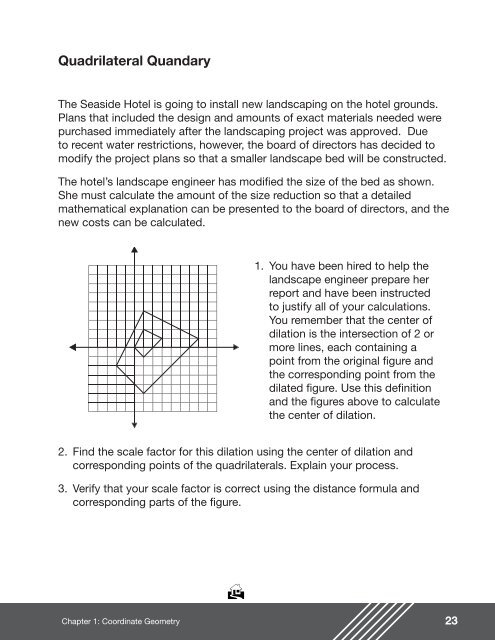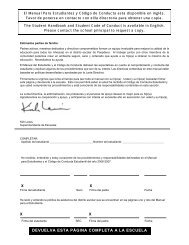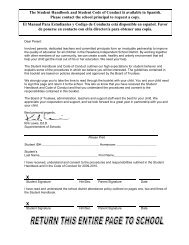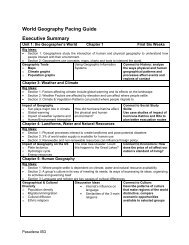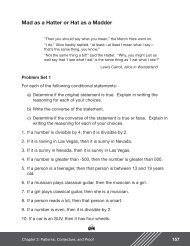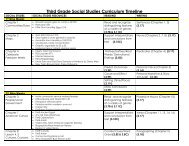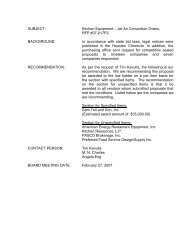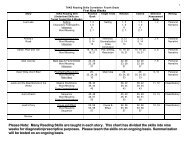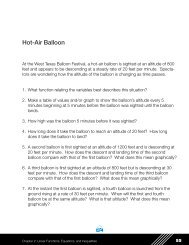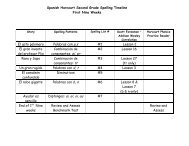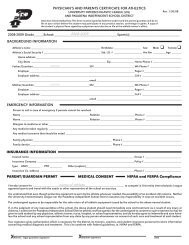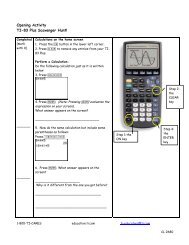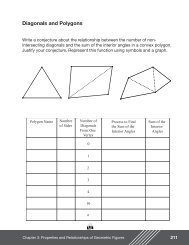Quadrilateral Quandary
Quadrilateral Quandary
Quadrilateral Quandary
You also want an ePaper? Increase the reach of your titles
YUMPU automatically turns print PDFs into web optimized ePapers that Google loves.
<strong>Quadrilateral</strong> <strong>Quandary</strong><br />
The Seaside Hotel is going to install new landscaping on the hotel grounds.<br />
Plans that included the design and amounts of exact materials needed were<br />
purchased immediately after the landscaping project was approved. Due<br />
to recent water restrictions, however, the board of directors has decided to<br />
modify the project plans so that a smaller landscape bed will be constructed.<br />
The hotel’s landscape engineer has modified the size of the bed as shown.<br />
She must calculate the amount of the size reduction so that a detailed<br />
mathematical explanation can be presented to the board of directors, and the<br />
new costs can be calculated.<br />
1. You have been hired to help the<br />
landscape engineer prepare her<br />
report and have been instructed<br />
to justify all of your calculations.<br />
You remember that the center of<br />
dilation is the intersection of 2 or<br />
more lines, each containing a<br />
point from the original figure and<br />
the corresponding point from the<br />
dilated figure. Use this definition<br />
and the figures above to calculate<br />
the center of dilation.<br />
2. Find the scale factor for this dilation using the center of dilation and<br />
corresponding points of the quadrilaterals. Explain your process.<br />
3. Verify that your scale factor is correct using the distance formula and<br />
corresponding parts of the figure.<br />
H<br />
Chapter 1: Coordinate Geometry<br />
23
Teacher Notes<br />
Materials:<br />
One graphing calculator per<br />
student<br />
Connections to Geometry<br />
TEKS:<br />
(d.2) Dimensionality and the<br />
geometry of location. The<br />
student understands that<br />
coordinate systems provide<br />
convenient and efficient ways of<br />
representing geometric figures<br />
and uses them accordingly.<br />
The student:<br />
(A) uses one- and twodimensional<br />
coordinate systems<br />
to represent points, lines, line<br />
segments, and figures;<br />
(B) uses slopes and equations<br />
of lines to investigate geometric<br />
relationships, including parallel<br />
lines, perpendicular lines, and<br />
special segments of triangles and<br />
other polygons; and<br />
(C) develops and uses formulas<br />
including distance and midpoint.<br />
(f) Similarity and the geometry<br />
of shape. The student applies the<br />
concepts of similarity to justify<br />
properties of figures and solve<br />
problems.<br />
Scaffolding Questions:<br />
• What kind of transformation is illustrated?<br />
• Why is it necessary to calculate the center of dilation?<br />
• Is the transformation rigid? Why or why not?<br />
• What does the scale factor tell you about the size of the<br />
new figure?<br />
• How does the value of the scale factor relate to the<br />
center of dilation?<br />
• How do the dimensions of the new figure relate to the<br />
scale factor?<br />
Sample Solutions:<br />
1. The center of dilation is the intersection of 2 or more<br />
lines, each containing a point from the original figure<br />
and a corresponding point from the dilated figure.<br />
The strategy used will be to find the equations of<br />
the intersecting lines, enter them into the graphing<br />
calculator, and find the point of intersection. That<br />
point of intersection will be the center of dilation.<br />
First, label the coordinates of the vertices of the<br />
quadrilaterals as follows: A(1,-5); B(7,1); C(1,4); D(-2,2) and<br />
E(1,-1); F(3,1); G(1,2); H(0,0).<br />
The student:<br />
(1) uses similarity properties<br />
and transformations to explore<br />
and justify conjectures about<br />
geometric figures; and<br />
C(1,4)<br />
G(1,2)<br />
(2) uses ratios to solve problems<br />
involving similar figures.<br />
(0,0) H<br />
F(3,1)<br />
B(7,1)<br />
D(-2,-2)<br />
E(1,-1)<br />
A(1,-5)<br />
H<br />
24 Chapter 1: Coordinate Geometry
Using the point-slope form, find the equation of the line that<br />
contains points A(1,-5) and E(1,-1) and an equation of the<br />
line containing D(-2,-2) and H(0,0).<br />
−2 − 0<br />
The calculation for the slope of line DH is 1: = 1 .<br />
−2 − 0<br />
The equation of line DH<br />
with H:<br />
y – 0 = 1 (x – 0)<br />
y = x<br />
is found using point-slope form<br />
The line AE is the vertical line x = 1. This line also passes<br />
through points C and G.<br />
To find the intersection point of the line y = x and x = 1<br />
substitute 1 for x.<br />
y = 1.<br />
The intersection point of the two lines is (1,1). The vertical<br />
line through points B and F is y = 1. This line also passes<br />
through the point (1,1).<br />
The center of dilation is (1,1). Label that point X on the<br />
diagram.<br />
2. The center of dilation and the points A(1,-5) and<br />
E(1,-1) can be used in determining the scale factor. The<br />
ratio of the distances between the center of dilation and<br />
the corresponding points on the quadrilateral determines<br />
the scale factor. To calculate the scale factor, solve the<br />
equation:<br />
XE<br />
scale factor =<br />
XA<br />
The distance formula is used to find the length of the<br />
segments.<br />
Texas Assessment of<br />
Knowledge and Skills:<br />
Objective 3: The student will<br />
demonstrate an understanding of<br />
linear functions.<br />
Objective 4: The student<br />
will formulate and use linear<br />
equations and inequalities.<br />
Objective 7: The student will<br />
demonstrate an understanding<br />
of two-and three-dimensional<br />
representations of geometric<br />
relationships and shapes.<br />
Objective 8: The student will<br />
demonstrate an understanding<br />
of the concepts of measurement<br />
and similarity.<br />
Connections to High School<br />
Geometry: Supporting the<br />
TEKS and TAKS Institute:<br />
II. Transformations: Up to Scale<br />
Teacher’s Comment:<br />
“Using the assessments has<br />
helped my students retain the<br />
concepts used. Before using<br />
the assessments my students<br />
would work problems and move<br />
on to more concepts losing<br />
retention. Now my students have<br />
real-world situations they relate<br />
the concepts with and retain the<br />
concepts used.”<br />
XE =<br />
( ) = + =<br />
2 2 2<br />
( 1−<br />
1) + 1− ( −1)<br />
0 2 2<br />
H<br />
Chapter 1: Coordinate Geometry<br />
25
The length of XA is calculated as follows:<br />
( ) + − ( )<br />
( ) = + =<br />
2 2 2<br />
XA = 1−<br />
1 1 −5 0 6 6<br />
.<br />
XE<br />
scale factor =<br />
XA = 2<br />
= 1<br />
6 3<br />
This scale factor is true for each pair of corresponding sides. Corresponding sides are<br />
DA and HE , DC , and HG , CB , and GF , AB and EF.<br />
DA =<br />
HE =<br />
( ) = ( ) + ( ) =<br />
2 2 2 2<br />
( −2 − 1) + −2 − ( −5)<br />
−3 −3 18<br />
( ) = ( ) + ( ) =<br />
2 2 2 2<br />
( − ) + − ( − ) −<br />
0 1 0 1 1 1 2<br />
HE<br />
The ratio of the lengths of sides is .<br />
DA = 2<br />
= 2<br />
18<br />
= 1<br />
18 9<br />
= 1<br />
3<br />
2 2 2 2<br />
( ) + ( − ) = ( ) + ( ) =<br />
DC = -2 − 1 -2 4 -3 -6 45<br />
2 2 2 2<br />
( ) + ( − ) = ( ) + ( ) =<br />
HG = 0 − 1 0 2 -1 -2 5<br />
HG<br />
The ratio of the lengths of sides is .<br />
DC = 5<br />
= 5<br />
45<br />
= 1<br />
45 9<br />
= 1<br />
3<br />
2 2 2 2<br />
( ) + ( − ) = ( ) + ( ) =<br />
CB = −1−<br />
7 4 1 -6 3 45<br />
2 2 2 2<br />
( ) + ( − ) = ( ) + ( ) =<br />
GF = 1−<br />
3 2 1 -2 1 5<br />
GF<br />
The ratio of the lengths of sides is .<br />
CB = 5<br />
= 5<br />
45<br />
= 1<br />
45 9<br />
= 1<br />
3<br />
H<br />
26 Chapter 1: Coordinate Geometry
2 2 2 2<br />
( ) + ( − ) = ( ) + ( ) =<br />
AB = 1−<br />
7 -5 1 -6 -6 72<br />
2 2 2 2<br />
( ) + ( − ) = ( ) + ( ) =<br />
EF = 1−<br />
3 -1 1 -2 -2 8<br />
EF<br />
The ratio of the lengths of sides is .<br />
AB = 8<br />
= 8<br />
72<br />
= 1<br />
72 9<br />
= 1<br />
3<br />
Extension Question:<br />
• Landscape timbers are sold in 8-foot lengths. Suppose the original project was<br />
designed for 850 feet of landscaping timber, at a cost of $1.39 per timber. Calculate the<br />
minimum amount of materials that will need to be ordered for the new bed and the cost<br />
of materials before tax. Explain how you arrived at your answers.<br />
The scale factor for the new project is<br />
of the original design plan. If the original project<br />
was designed for 850 feet of landscaping timber, the new project will require<br />
1<br />
3<br />
(850 feet) = 283.3 feet.<br />
1<br />
3<br />
1<br />
3<br />
as much.<br />
If the timbers are 8 feet long, divide 283.3 by 8. The result is 35.4125 timbers. Timbers are<br />
sold in 8-foot lengths; therefore, a minimum of 36 will be needed.<br />
The cost of the project per landscape bed is calculated by multiplying $1.39 by 36 timbers.<br />
1.39 (36) = 50.04<br />
The cost for each landscape bed will be $50.04.<br />
H<br />
Chapter 1: Coordinate Geometry<br />
27
Student Work Sample<br />
The problem analysis on the next page was created by a group of students. The students<br />
were given the problem, told to work silently on the problem for at least three minutes, and<br />
asked to create a group poster of their analysis of the problem.<br />
The work is a good example of:<br />
• Shows a relationship among the elements.<br />
They demonstrated their understanding of which points corresponded to one<br />
another and used the appropriated labeling (A, A’).<br />
• Uses appropriate terminology and notation.<br />
The students used correct language for transformations (image, dilation, scale<br />
factor). They wrote and used the formulas for distance between two points.<br />
The students neglected to give reasons for the steps and to explain why the point (1,1) is<br />
the center of dilation.<br />
H<br />
28 Chapter 1: Coordinate Geometry
H<br />
Chapter 1: Coordinate Geometry<br />
29


